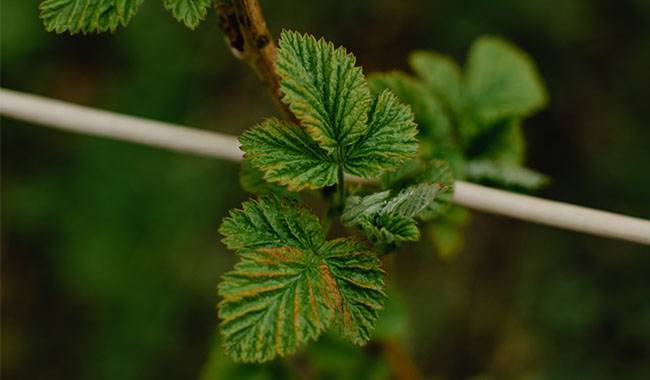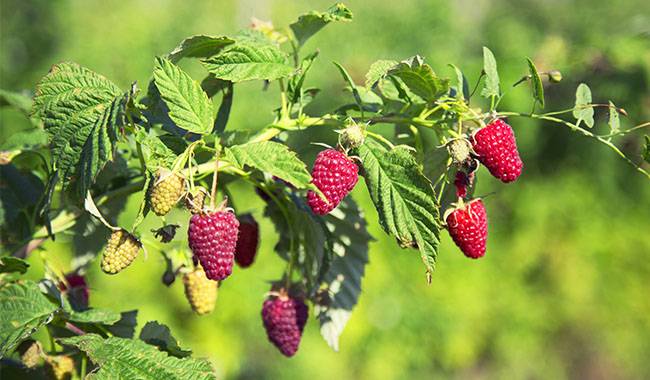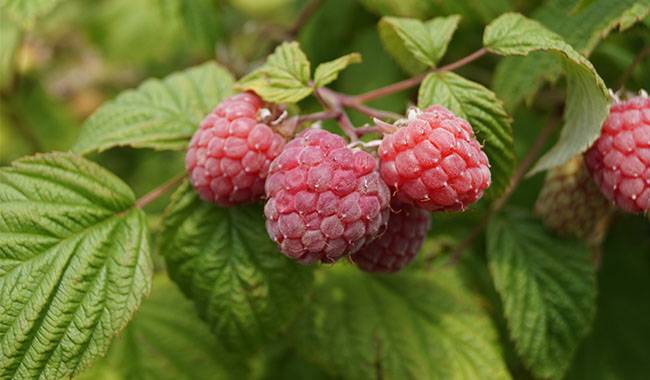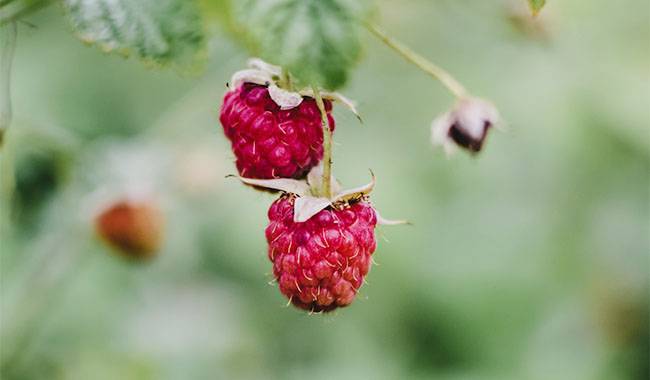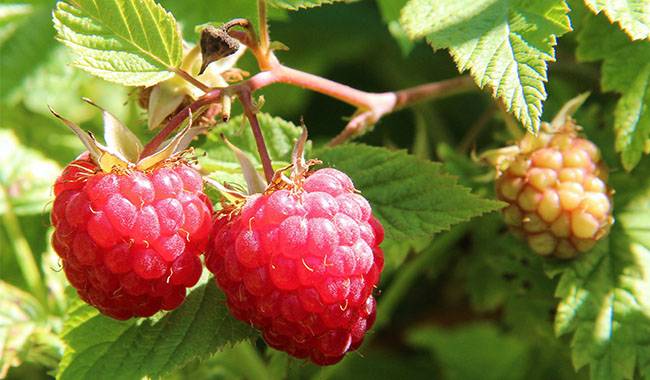
Raspberry is the most popular berry in the garden. For the shrub to keep forming a good crop of large berries, raspberries need careful care, especially during the spring. Spring care consists of a set of procedures that should be introduced into the system and implemented annually.
Raspberry bush care in the form of acting alone during spring will not bring benefits to the beloved berries while the owner. In the form of a sweet harvest, it gets satisfaction.
WHEN DO I START SPRING WORK IN THE RASPBERRY GARDEN?
Spring care for raspberry begins in the first month of spring. A mandatory set of annual treatments includes.
- Hot bath.
- Pruning.
- Soil care.
- Bundling.
- Fertilizing.
- Watering.
- Pest control.
- Disease protection.
HOT WATER SHOWER FOR RASPBERRY
- In the first days of March, still in the snow, shovel away from the raspberry bushes the garbage that has accumulated over the winter and removes it from the plot (if this work was not done in the fall).
- Be sure to burn the trash because pests can overwinter in it, and the semi-decomposed leaves can contract fungal diseases.
- Heat water to boiling and fill a 1.3 Gal (5 liters) watering can.
- Water the raspberry bush from a height of about 27-40inch (0.7-1m) through a spigot with a diffuser.
This procedure is not harmful to the raspberry. When the hot water reaches the bush, its temperature will drop to 158°F (70°C) or less. Such water temperatures will not harm the sleeping raspberry buds but will cause the death of many pests, including nematodes, and it is impossible to get rid of them with any poison.
On average, 1 tank of hot water is enough to treat 2-4 bushes. If the raspberry bush is large (10-15 branches), water 2 bushes with a 1.3 Gal (5 liters) watering can.
SPRING PRUNING OF RASPBERRIES
After a hot shower, raspberry bushes are cut and shaped once positive temperatures have been established and the topsoil has dried out.
Regardless of the method used to grow raspberry, it is more practical to prune in 2 stages.
In the first stage, weak shoots, knotty, bent, thickened branches, and stems with swollen bottoms (where gall midge larvae spend the winter) are removed at ground level. The remaining stems should be thinned out, leaving 6-8 stems for the bush formation and a maximum of 15-20 stems per 40inch extension for furrow planting. Intensification will result in reduced yields and crushed berries.
The second stage of raspberry spring pruning is done when a stable positive air temperature of no less than 41°F (5°C) is established. During this period, flower buds have opened, the tips of cultured buds have entered the growth stage, and the overwintering of the bush can be clearly seen. The final revision eliminated the raspberry’s leaky fruiting stems and frosted the stem tops.
Healthy raspberry stems were pruned to 8inch (20cm) long to obtain additional lateral fruiting buds, and frosted raspberries were cut to the first live bud. Spring pruning of raspberries is important because it creates optimal conditions that help develop a productive crop and increase the cultivar’s fruiting period.
SOIL TILLAGE IN THE RASPBERRY GARDEN
After pruning, everything that is left over should be burned off. To trample the soil of the raspberry garden, it is necessary to lay boards, smooth pieces of slate, or other bedding material between the rows and work only from these bedding materials without stepping into the rows of the raspberry garden.
In the rows, loosen the soil no deeper than 3-4inch (8-10 cm), eliminate weeds, water and cover with a layer of mulch up to 6inch (15 cm). As mulch for raspberry, straw, compost, and hummus can be used. Mulch saves moisture, which evaporates quickly in the spring sun and wind. Organic mulch is a good source of nutrients for the raspberry root system. It is not possible to mulch over moist soil where groundwater is located close by. They are only loosened after fertilization and watering.
To keep new areas of raspberry berries from becoming cluttered, enclose them with smooth slate, galvanized, and other materials to a depth of 6-8inch (15-20 cm).
RASPBERRY GARTER
When growing in colder areas, raspberry is removed from its stand for the winter, which reduces the likelihood of it frosting in negative conditions of severe weather. If the trellis or bush method is used, proceed to tie the raspberry bush after pruning and cleaning. Trellises and stakes are most often used for large-fruited varieties.
With the trellis method, raspberry bushes are kept at least 23-28inch (60-70 cm) apart. The stems fork into a fan shape and are spaced 4-5inch (10-13 cm) apart on the trellis. Each stem is tied to a horizontal wire in 2 places so that the top does not fall off.
In raspberry bush formation, a stake is hammered between 2 bushes, and half of each bush is taken out and tied to the stake (each stem is separated). In this tying method, a stepwise pruning of the stems was used. Each stem was cut into different heights of 4-6-8inch (10-15-20 cm).
When growing raspberries on poles, the plants do not shade each other, more berries ripen at the same time, and the fruit is more comfortable to harvest.
SPRING FERTILIZATION OF RASPBERRIES
Although fertilizer is applied annually in the fall, raspberries are also fertilized in the spring. Fertilization is especially necessary for raspberries on poor soils. Fertilizer is applied in the form of a solution or solid granules. Fertilizer should always be applied with watering and then covered with a layer of mulch no less than 2inch (5cm).
During the vegetative stage, raspberry should be fertilized 3 times.
The first feeding of raspberry is done immediately after the snow melts.
Usually, nitrate fertilizer, compound fertilizer, and other types of mineral fertilizers are applied under raspberry. The standard for mineral fertilizers is 60-80 grams/11 square feet. On poor soils, increase the fertilizer application to 80-100 g/11 sq. ft.
You can make ammonia, but preferably potassium nitrate or urea at 30-40 grams per 11 square feet, while introducing wood ash to 150 grams per bush. The ash helps deoxygenate the soil, which is acidified due to the frequent use of ammonium nitrate. In addition, ashes are rich in micro and macro elements.
Organic fertilizers such as humus or compost can be used for the first application every year or every other year at 6.5-11 Lb (3-5 kg) per 11 sq ft.
Once the fertilizer has been applied, the raspberry bed should be watered. After absorbing water, mulch with humus, peat, shavings, straw, and other types of mulch. When applying organic fertilizers, do not use humus mulch.
Raspberry’s second feeding (the stage when the ovaries start to form) takes place within 25-30 days.
Usually, this feeding is carried out with organic manure. 1-2 Lb (0.5-1 kg) of manure or poultry manure was diluted in 2.5-3 Gal (10-12 L) and 3-4 Gal (12-15 L) of water, respectively. The solution consumption per running meter was 0.5-0.8 Gal (2-3 liters). Despite the application of fertilizer in the form of a solution, there is an obligation to water and mulch the soil after the application.
If the first application of organic fertilizer is made, the second is applied in calcium superphosphate and potash at the rate of 30-40 and 20-25 g per 11 sq. ft. respectively.
The third feeding of C. raspberry was done at the end of the harvest.
Shallow replanting of 6-8inch (15-20 cm) between the rows was done so that the main mineral fertilizer was 80-120 grams per 11 square feet area.
WATERING RASPBERRIES
Since raspberries are very sensitive to the provision of water, there is no strict watering schedule. They are based on the state of the raspberry bed and weather conditions. raspberries require particularly frequent and adequate watering during flowering and ovary formation. Due to lack of water, the berries become smaller, drier, and harder. Watering is carried out along furrows. The soil should be saturated to a 4-6inch (10-15 cm) layer of water. Mulching must be done at the end of irrigation.
PROTECTING RASPBERRIES FROM PESTS AND DISEASES
Like all garden crops, raspberries are susceptible to diseases (powdery mildew, anthracnose, purple spot, etc.) and pests (raspberry gall, mites, stem flies, raspberry beetles, etc.). The use of chemical means to prevent pests and diseases on raspberry is prohibited. Only biological agents are allowed for treatment.
With raspberry, preventive measures should be taken first:
- The plot is kept clean and free of weeds, pruning residues, and other debris that can serve as a shelter for breeding and overwintering pests.
- Fertilization and watering are done according to agricultural engineering requirements, so that excess water and fertilizer do not trigger diseases from fungal and bacterial viral infections.
Treating raspberry with chemicals
In early spring, before germination, treat raspberry with Bordeaux mixture at 3%. it is used separately from other preparations and means.
Plant treatment with biological agents
During the budding stage and early flowering, raspberry can be treated against diseases.
Trichodermin,
Glyokladin,
Baсtofit,
Alirin-B.
Recommended preparations for the control of raspberry pest infestations.
Verticillium,
Bitoxibacillin,
Penicillin.
Biological insecticides and biological fungicidal preparations can be used in tank mixtures according to the recommendations. Maximum effectiveness can be achieved by diluting biological agents according to the instructions. Increasing the concentration as well as decreasing it will not produce the desired effect.
More related information about growing raspberry bush




